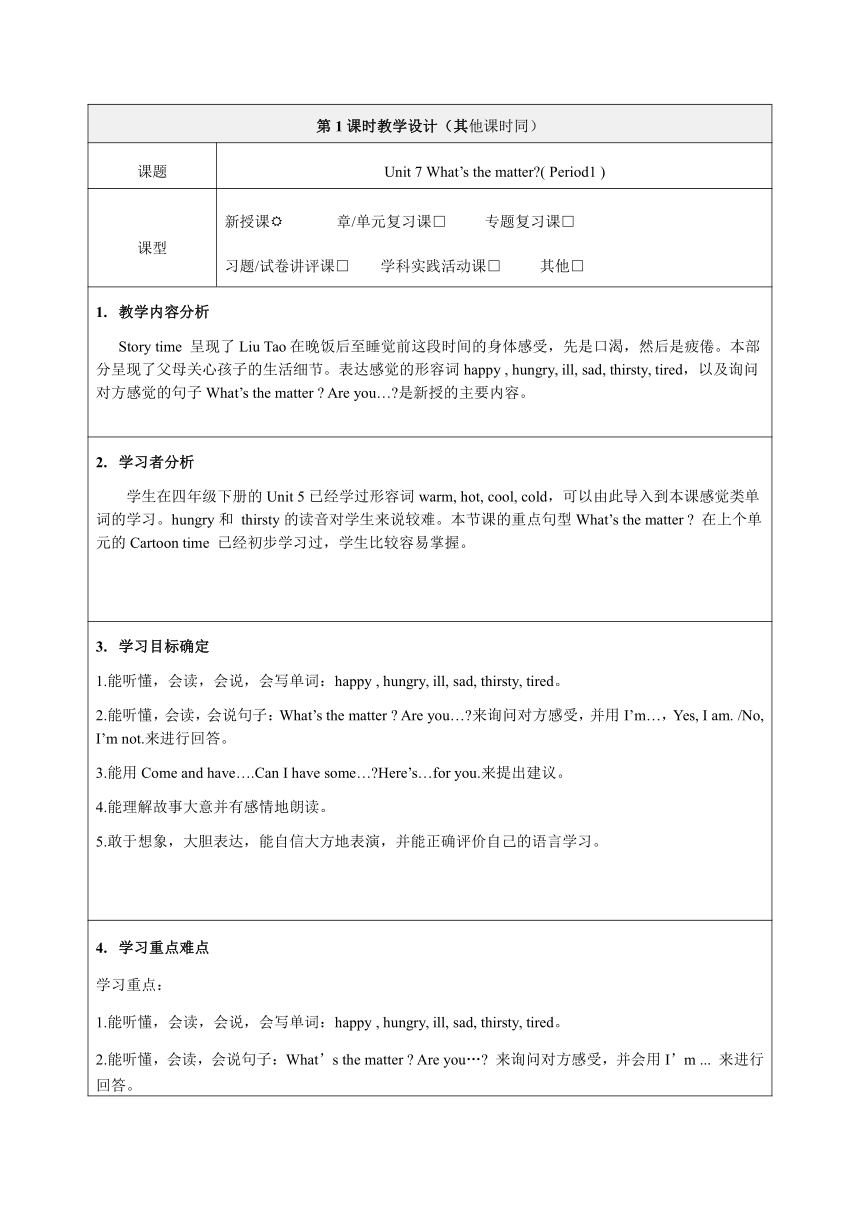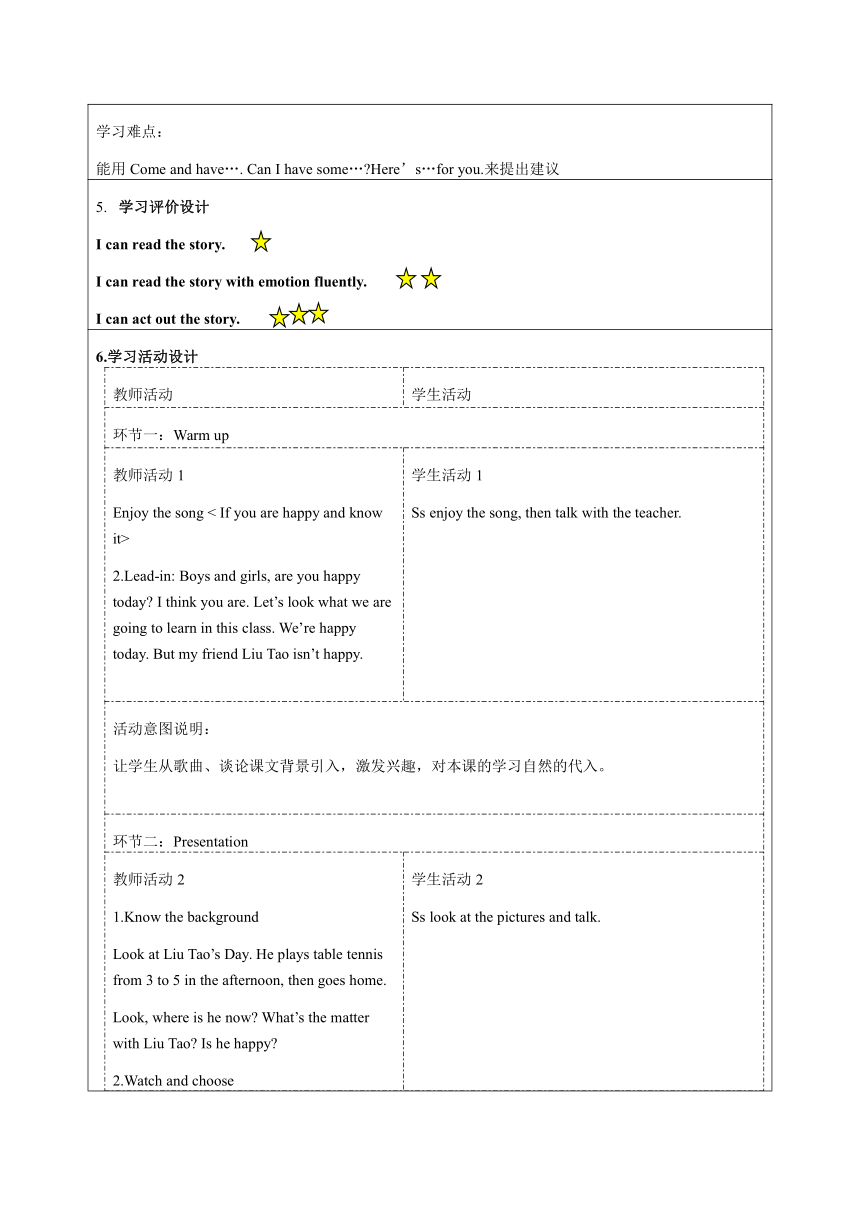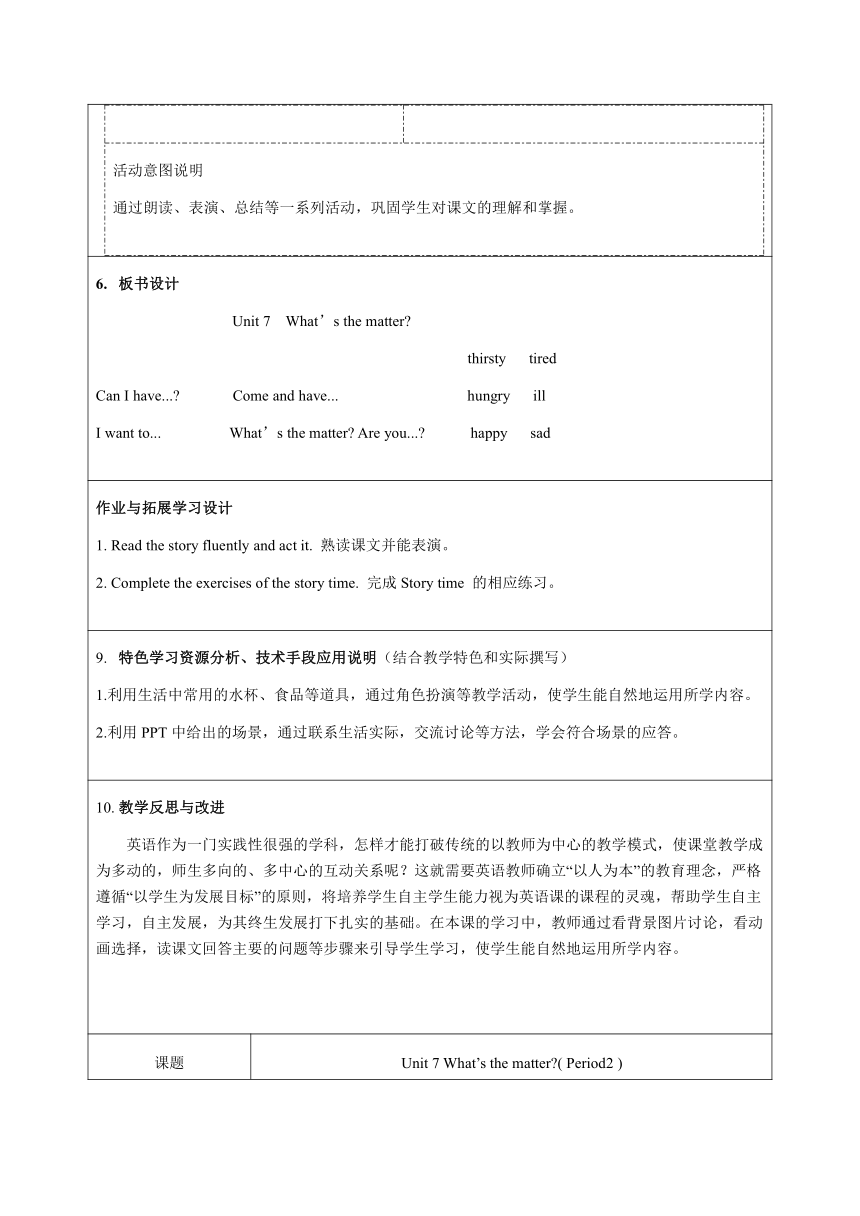Unit7What's the matter? 单元教学设计(表格式) 2024-2025学年鲁教版(五四学制)英语七年级下册
文档属性
| 名称 | Unit7What's the matter? 单元教学设计(表格式) 2024-2025学年鲁教版(五四学制)英语七年级下册 |

|
|
| 格式 | docx | ||
| 文件大小 | 54.1KB | ||
| 资源类型 | 教案 | ||
| 版本资源 | 鲁教版 | ||
| 科目 | 英语 | ||
| 更新时间 | 2025-03-14 15:54:09 | ||
图片预览





文档简介
单元(或主题)名称 Unit 7 What’s the matter
单元(或主题)教学设计说明 本单元的话题是询问和表达“感受”或“感觉”。在教学中,教师可以结合生活中的情景,让学生在角色扮演中学会关心帮助他人。本单元的目标词汇是表示感受或感觉的形容词,在教学过程中,教师可以结合四年级下册Unit5 Seasons中的形容词warm ,hot, cool, cold来设计导入活动。教师可以准备水杯、食物等道具用语课堂教学,以创设出较为真实的语用情景,方便学生角色体验。
单元(或主题)学习目标与重点难点 (一) 知识技能目标 1.能熟练听懂、会读、会说、会拼写单词thirsty,water,tired,ill, happy。 2.能熟练听懂、会说、会读、会运用句型What’s the matter 及其回答I’m ...,日常交际用语Come and have... I want to... Good night. 3.能熟练听懂、会读、会说单词: dear, Mrs, speak。 4.能理解并掌握字母o的发音规律,熟记例词。 5.能诵读歌谣:Are you ill (二)能力目标 能用所学知识点表达对他人的关心。 情感目标 鼓励学生积极参加课外活动以及聚会,学会正确的接人待物的方式。 培养学生建立良好的人际交往关系。 3.培养学生关心他人的意识。 教学重点: 能熟练听懂、会说、会读、会运用句型What’s the matter 及其回答I’m ...,日常交际用语Come and have... I want to... Good night. 教学难点 能熟练听懂、会说、会读、会运用句型What’s the matter 及其回答I’m ...,日常交际用语Come and have...;I want to...; Good night. 能理解并掌握字母o的发音规律
单元(或主题)整体教学思路(教学结构图) 第一课时:Story time 第二课时:Fun time ,Cartoon time 第三课时:Sound time, Rhyme time, Checkout time
第1课时教学设计(其他课时同)
课题 Unit 7 What’s the matter ( Period1 )
课型 新授课 章/单元复习课□ 专题复习课□ 习题/试卷讲评课□ 学科实践活动课□ 其他□
教学内容分析 Story time 呈现了Liu Tao在晚饭后至睡觉前这段时间的身体感受,先是口渴,然后是疲倦。本部分呈现了父母关心孩子的生活细节。表达感觉的形容词happy , hungry, ill, sad, thirsty, tired,以及询问对方感觉的句子What’s the matter Are you… 是新授的主要内容。
学习者分析 学生在四年级下册的Unit 5已经学过形容词warm, hot, cool, cold,可以由此导入到本课感觉类单词的学习。hungry和 thirsty的读音对学生来说较难。本节课的重点句型What’s the matter 在上个单元的Cartoon time 已经初步学习过,学生比较容易掌握。
学习目标确定 1.能听懂,会读,会说,会写单词:happy , hungry, ill, sad, thirsty, tired。 2.能听懂,会读,会说句子:What’s the matter Are you… 来询问对方感受,并用I’m…,Yes, I am. /No, I’m not.来进行回答。 3.能用Come and have….Can I have some… Here’s…for you.来提出建议。 4.能理解故事大意并有感情地朗读。 5.敢于想象,大胆表达,能自信大方地表演,并能正确评价自己的语言学习。
学习重点难点 学习重点: 1.能听懂,会读,会说,会写单词:happy , hungry, ill, sad, thirsty, tired。 2.能听懂,会读,会说句子:What’s the matter Are you… 来询问对方感受,并会用I’m ... 来进行回答。 学习难点: 能用Come and have…. Can I have some… Here’s…for you.来提出建议
学习评价设计 I can read the story. I can read the story with emotion fluently. I can act out the story.
6.学习活动设计 教师活动学生活动环节一:Warm up教师活动1 Enjoy the song < If you are happy and know it> 2.Lead-in: Boys and girls, are you happy today I think you are. Let’s look what we are going to learn in this class. We’re happy today. But my friend Liu Tao isn’t happy. 学生活动1 Ss enjoy the song, then talk with the teacher. 活动意图说明: 让学生从歌曲、谈论课文背景引入,激发兴趣,对本课的学习自然的代入。 环节二:Presentation教师活动2 1.Know the background Look at Liu Tao’s Day. He plays table tennis from 3 to 5 in the afternoon, then goes home. Look, where is he now What’s the matter with Liu Tao Is he happy 2.Watch and choose What’s the matter with Liu Tao He’s … A. happy B. hungry C. thirsty D. ill E. tired(使用单词卡) Teach: thirsty, tired, ill 3.Read the story What would Liu Tao like Teach: Can I have... I want to... What do Dad and Mum say Teach: Come and have... What’s the matter Are you... 4.Image what Dad and Mum say. 学生活动2 Ss look at the pictures and talk. Ss watch the flash and find the question. Ss read and circle. Ss say the other sentences. Ss read and learn. Ss talk and say. 活动意图说明 通过看背景图片讨论,看动画选择,读课文回答主要的问题等步骤来引导学生学习。 环节三:Consolidation教的活动3 1. Let’s read. 2.Summary . 3.Enjoy a flash 学的活动3 1.Read after the computer. Work in groups of four, and read in roles. Read and act. 3.Enjoy a flash 活动意图说明 通过朗读、表演、总结等一系列活动,巩固学生对课文的理解和掌握。
板书设计 Unit 7 What’s the matter thirsty tired Can I have... Come and have... hungry ill I want to... What’s the matter Are you... happy sad
作业与拓展学习设计 1. Read the story fluently and act it. 熟读课文并能表演。 2. Complete the exercises of the story time. 完成Story time 的相应练习。
特色学习资源分析、技术手段应用说明(结合教学特色和实际撰写) 1.利用生活中常用的水杯、食品等道具,通过角色扮演等教学活动,使学生能自然地运用所学内容。 2.利用PPT中给出的场景,通过联系生活实际,交流讨论等方法,学会符合场景的应答。
教学反思与改进 英语作为一门实践性很强的学科,怎样才能打破传统的以教师为中心的教学模式,使课堂教学成为多动的,师生多向的、多中心的互动关系呢?这就需要英语教师确立“以人为本”的教育理念,严格遵循“以学生为发展目标”的原则,将培养学生自主学生能力视为英语课的课程的灵魂,帮助学生自主学习,自主发展,为其终生发展打下扎实的基础。在本课的学习中,教师通过看背景图片讨论,看动画选择,读课文回答主要的问题等步骤来引导学生学习,使学生能自然地运用所学内容。
课题 Unit 7 What’s the matter ( Period2 )
课型 新授课 章/单元复习课□ 专题复习课□ 习题/试卷讲评课□ 学科实践活动课□ 其他□
教学内容分析 Fun time 是一个“演一演,猜一猜”的游戏,要求学生两人活动,一人做动作或表情,另一人猜测并询问,猜对后,要给予具体的帮助。在游戏过程中,教师可以鼓励学生夸张地做表情和肢体动作,也可以和学生一起,在课前做好相应的准备。 Cartoon time的故事再现了本单元的重点句子What’s the matter ,同时也渗透了下一个单元的电话用语“This is ... speaking.”。
学习者分析 Fun time和 Cartoon time的内容“说、演、猜”一体,学生对猜一猜的游戏充满兴趣。在上一节课也学习过 What’s the matter Are you... 及其应答。因此,学生是能顺利并乐于进入本部分的学习的。
学习目标确定 能听懂会说、会拼读单词happy , hungry, ill, sad, thirsty, tired。 能听懂、会说、会读句型What’s the matter Are you… Here’s…for you。
学习重点难点 学习重点: 1.能听懂、会说、会拼读单词happy , hungry, ill, sad, thirsty, tired。 2.能听懂、会说、会读句型What’s the matter Are you… Here’s…for you 学习难点: 1.能听懂、会说、会读句型What’s the matter Are you… Here’s…for you
学习评价设计 I can use “What’s the matter ” I can talk about feelings. I can read and understand the story in Cartoon time.
6.学习活动设计 教师活动学生活动环节一:Review教师活动1 1. Free talk Good morning. How are you What’s the matter with you 2.Review the story What’s the matter with Liu Tao 学生活动1 Ss talk with the teacher. Fill in the blanks. 活动意图说明: 通过与学生的日常交谈到回忆复习上节课故事内容,让学生更好地复述故事,回忆重点词汇。环节二:Presentation教师活动2 1.Teach the words of feelings. 2.Chant. 3.Fun time How to help Make a model. Show the rules. Send a sentence.(True happiness comes from helping others.) 4.Cartoon time Watch and answer: What’s the matter with Bobby? Read and answer: Is Bobby happy at last Why Read the cartoon and find the phone call. Read and think 学生活动2 Ss learn the words. Work in pairs and make dialogues. Ss read and find the sentence about calling. 活动意图说明 集中学习巩固感觉类形容词,通过图片创设情境,进行操练,让学生能根据具体情境学会不同的恰当的回应。Cartoon time学习中,弄清楚Bobby的状况后,通过再读故事,了解提前渗透的有关打电话的交际用语。 环节三:Consolidation教的活动3 Let’s read. Let’s dub. Let’s act. 学的活动3 1.Read after the tape. Dub in groups. 3.Let’s act. Work in groups. 4.Do some exercise. 活动意图说明 通过朗读,配音,表演形式进一步巩固课文。设计的练习巩固学习重点。
7.板书设计 Unit 7 What’s the matter What’s the matter Are you... I’m … Here’s … /Have … /…
作业与拓展学习设计 1. Read and copy the new words. 2.Write the dialogue using the sentences that we have learned.
特色学习资源分析、技术手段应用说明 1.利用PPT 设计情境,引导学生创编,提高创造力和学习英语的兴趣。 2.小组合作,再现学生生活中熟悉的场景,让学生在真实的情境中学会关心帮助他人。
教学反思与改进 教师不只要教给学生知识,更重要的是要交给他们自主学习的方法。古语说:授人以鱼不如授人以渔。这就需要在平时的教学中注意渗透和指导,并鼓励学生通过自主学习掌握方法,达到自由运用,比如在本课时中,让学生说一说在写小诗时可以用哪些句型,让他们不仅牢固的掌握了新知识,而且更有利的开发他们自主和创新的学习潜能。 本节课整体上看来,学生都能自主参与到课堂学习中来,但在个别环节,学生的创新意识并不强,如在谈论季节活动时,大部分学生只能说用书上的句子来,而不能自己组织语言来介绍。如果在设计教案时考虑学生的现有能力,降低练习的难度,相信大部分学生都能积极参与,更加体现本课的实效性。
课题 Unit 7 What’s the matter ( Period3 )
课型 新授课 章/单元复习课 专题复习课□ 习题/试卷讲评课□ 学科实践活动课□ 其他□
教学内容分析 本节课的主要内容为复习前两节课所学内容,完成Checkout time 的内容,新授Sound time, Rhyme time.,Sound time呈现了字母O的发音,需要学生能体会其发音并分辨。Rhyme time呈现了小男孩Bill不愿吃药的情景。
学习者分析 经过前面两节课的学习,大部分学生已能正确朗读并理解本单元的生词句,能运用What’s the matter Are you happy/hungry /ill/sad/thirsty /tired I’m happy/hungry /ill/sad/thirsty /tired . Here’s… for you等表达进行交流,但在具体运用中,仍会出现错误。 Sound time呈现了字母O的发音,大部分学生能正确体会,但与其他含有O字母的单词读音进行分辨,还是有难度的。Rhyme time中第二句“Is sitting still”比较难理解,需要教师指导。
学习目标确定 1.能听懂,会读,会说,会写单词:happy , hungry, ill, sad, thirsty, tired。 2.能听懂,会读,会说句子:What’s the matter Are you happy/hungry /ill/sad/thirsty /tired I’m happy/hungry /ill/sad/thirsty /tired . Here’s… for you。 3.能了解字母o在单词中的读音,即/ u /。 4.会熟练朗读Rhyme time。
学习重点难点 学习重点: 1.能听懂,会读,会说,会写单词:happy , hungry, ill, sad, thirsty, tired。 2.能听懂,会读,会说句子:What’s the matter Are you happy/hungry /ill/sad/thirsty /tired I’m happy/hungry /ill/sad/thirsty /tired . Here’…for you。 3.能了解字母o在单词中的读音,即/ u /。 4.会熟练朗读Rhyme time。 学习难点: 1.根据图片提示,能大声流利地朗读并与同桌对话。 2.能了解字母o在单词中的读音,即/ u/。
学习评价设计 I know the sound of the letter “O”. I can say the rhyme < Are you ill >. I can use “What’s the matter Are you... I’m ... Here’…for you” to ask and answer.
6.学习活动设计 教师活动学生活动环节一:Revision教师活动1 1.Let’s play. 2.Let’s read. 3.Let’s act. 学生活动1 Look at the pictures or words, say it. Read and spell the words. Act and guess 活动意图说明: 通过看图游戏复习单词,表演猜复习重点句型,学生能兴趣盎然中得到巩固。 环节二:Checkout time& Rhyme time教师活动2 1. Look and say (1)Guess: What’s the matter with Mike Talk about Picture1. (2)Work in pairs, then talk about Picture2. 2. Rhyme time. (1) Talk the picture. Look at this boy. His name is Bill.(Teach: Bill) Is he happy What’s the matter with Bill Can you give him some suggestions Look, his mother is coming. What can you see in her hands (Teach: pill) (2) Follow the flash. Read in groups , try to think over, what can you find from this rhyme 学生活动2 Ss talk with the teacher, then work in pairs. Ss talk about the picture and answer the questions. Ss talk abot the question freely. Ss read the rhyme. 活动意图说明 通过表演猜游戏自然过渡到看图猜,讨论练习,学生的训练由口头到笔头。小诗的学习从讨论图片,理解内容,再到体会韵脚,也符合学习规律。 环节三:Sound time教的活动3 1. Show the picture and ask: Who are they (Teach: Joe, Rose) 2.Let’s listen and repeat. 3.What is the letter “o” pronounced 4.Can you find the other words which contains “o” and pronounced / u / 5.I have some words here. Can you read them Does the letter “o” pronounce the same sound 6.Can you help them find the right house 学的活动3 1.Ss answer the questions and learn the new words. 2.Ss read the rhyme. 3.Ss read the words, and find the pronunciation of “o” 4.Ss try to say more words. 5.Ss read and learn. 6.Help the words find the right house 7.Do some exercise. 活动意图说明 通过读词,读句,掌握字母o的发音规律,经过朗读比对感受o的不同发音,并进行练习巩固。
板书设计 Unit 7 What’s the matter What’s the matter Are you happy/hungry /ill/sad/thirsty /tired I’m happy/hungry /ill/sad/thirsty /tired . Here’s …… for you .
作业与拓展学习设计 1.诵读Sound time,进一步了解字母o在单词中的发音。 2.进一步完善Checkout time的对话,演一演,猜一猜。 3. 选做作业:完善Checkout time的对话,并写一写。
特色学习资源分析、技术手段应用说明(结合教学特色和实际撰写) 1.利用多媒体,用丰富的朗读、表演形式来帮助学生强化语言知识,训练语言技能。 2.小组合作,将所学含有“O”的单词进行总结,通过朗读、辨析,体会字母o的发音规律。
教学反思与改进 上课之前,我先出示教学目标,让学生对本节课的教学有清晰的印象。 在Act and guess这一环节,学生参与的积极性都比较高,但在展示的过程中,大家会忽略了台下的大多数学生,在那些学生表演的过程当中,很多同学都没有积极跟上学生的思维,也没有及时进行纠错,只达到了表演的目的,而没有达到巩固知识的目的。 在自主学习这一环节,学生们以小组为单位进行合作学习,积极性都比较高,而且也到达了预期的效果,在学生们的共同努力下,学生都能自主本环节的自学任务,并且能够合作找出重难点,真正达到学习目标。
单元(或主题)教学设计说明 本单元的话题是询问和表达“感受”或“感觉”。在教学中,教师可以结合生活中的情景,让学生在角色扮演中学会关心帮助他人。本单元的目标词汇是表示感受或感觉的形容词,在教学过程中,教师可以结合四年级下册Unit5 Seasons中的形容词warm ,hot, cool, cold来设计导入活动。教师可以准备水杯、食物等道具用语课堂教学,以创设出较为真实的语用情景,方便学生角色体验。
单元(或主题)学习目标与重点难点 (一) 知识技能目标 1.能熟练听懂、会读、会说、会拼写单词thirsty,water,tired,ill, happy。 2.能熟练听懂、会说、会读、会运用句型What’s the matter 及其回答I’m ...,日常交际用语Come and have... I want to... Good night. 3.能熟练听懂、会读、会说单词: dear, Mrs, speak。 4.能理解并掌握字母o的发音规律,熟记例词。 5.能诵读歌谣:Are you ill (二)能力目标 能用所学知识点表达对他人的关心。 情感目标 鼓励学生积极参加课外活动以及聚会,学会正确的接人待物的方式。 培养学生建立良好的人际交往关系。 3.培养学生关心他人的意识。 教学重点: 能熟练听懂、会说、会读、会运用句型What’s the matter 及其回答I’m ...,日常交际用语Come and have... I want to... Good night. 教学难点 能熟练听懂、会说、会读、会运用句型What’s the matter 及其回答I’m ...,日常交际用语Come and have...;I want to...; Good night. 能理解并掌握字母o的发音规律
单元(或主题)整体教学思路(教学结构图) 第一课时:Story time 第二课时:Fun time ,Cartoon time 第三课时:Sound time, Rhyme time, Checkout time
第1课时教学设计(其他课时同)
课题 Unit 7 What’s the matter ( Period1 )
课型 新授课 章/单元复习课□ 专题复习课□ 习题/试卷讲评课□ 学科实践活动课□ 其他□
教学内容分析 Story time 呈现了Liu Tao在晚饭后至睡觉前这段时间的身体感受,先是口渴,然后是疲倦。本部分呈现了父母关心孩子的生活细节。表达感觉的形容词happy , hungry, ill, sad, thirsty, tired,以及询问对方感觉的句子What’s the matter Are you… 是新授的主要内容。
学习者分析 学生在四年级下册的Unit 5已经学过形容词warm, hot, cool, cold,可以由此导入到本课感觉类单词的学习。hungry和 thirsty的读音对学生来说较难。本节课的重点句型What’s the matter 在上个单元的Cartoon time 已经初步学习过,学生比较容易掌握。
学习目标确定 1.能听懂,会读,会说,会写单词:happy , hungry, ill, sad, thirsty, tired。 2.能听懂,会读,会说句子:What’s the matter Are you… 来询问对方感受,并用I’m…,Yes, I am. /No, I’m not.来进行回答。 3.能用Come and have….Can I have some… Here’s…for you.来提出建议。 4.能理解故事大意并有感情地朗读。 5.敢于想象,大胆表达,能自信大方地表演,并能正确评价自己的语言学习。
学习重点难点 学习重点: 1.能听懂,会读,会说,会写单词:happy , hungry, ill, sad, thirsty, tired。 2.能听懂,会读,会说句子:What’s the matter Are you… 来询问对方感受,并会用I’m ... 来进行回答。 学习难点: 能用Come and have…. Can I have some… Here’s…for you.来提出建议
学习评价设计 I can read the story. I can read the story with emotion fluently. I can act out the story.
6.学习活动设计 教师活动学生活动环节一:Warm up教师活动1 Enjoy the song < If you are happy and know it> 2.Lead-in: Boys and girls, are you happy today I think you are. Let’s look what we are going to learn in this class. We’re happy today. But my friend Liu Tao isn’t happy. 学生活动1 Ss enjoy the song, then talk with the teacher. 活动意图说明: 让学生从歌曲、谈论课文背景引入,激发兴趣,对本课的学习自然的代入。 环节二:Presentation教师活动2 1.Know the background Look at Liu Tao’s Day. He plays table tennis from 3 to 5 in the afternoon, then goes home. Look, where is he now What’s the matter with Liu Tao Is he happy 2.Watch and choose What’s the matter with Liu Tao He’s … A. happy B. hungry C. thirsty D. ill E. tired(使用单词卡) Teach: thirsty, tired, ill 3.Read the story What would Liu Tao like Teach: Can I have... I want to... What do Dad and Mum say Teach: Come and have... What’s the matter Are you... 4.Image what Dad and Mum say. 学生活动2 Ss look at the pictures and talk. Ss watch the flash and find the question. Ss read and circle. Ss say the other sentences. Ss read and learn. Ss talk and say. 活动意图说明 通过看背景图片讨论,看动画选择,读课文回答主要的问题等步骤来引导学生学习。 环节三:Consolidation教的活动3 1. Let’s read. 2.Summary . 3.Enjoy a flash 学的活动3 1.Read after the computer. Work in groups of four, and read in roles. Read and act. 3.Enjoy a flash 活动意图说明 通过朗读、表演、总结等一系列活动,巩固学生对课文的理解和掌握。
板书设计 Unit 7 What’s the matter thirsty tired Can I have... Come and have... hungry ill I want to... What’s the matter Are you... happy sad
作业与拓展学习设计 1. Read the story fluently and act it. 熟读课文并能表演。 2. Complete the exercises of the story time. 完成Story time 的相应练习。
特色学习资源分析、技术手段应用说明(结合教学特色和实际撰写) 1.利用生活中常用的水杯、食品等道具,通过角色扮演等教学活动,使学生能自然地运用所学内容。 2.利用PPT中给出的场景,通过联系生活实际,交流讨论等方法,学会符合场景的应答。
教学反思与改进 英语作为一门实践性很强的学科,怎样才能打破传统的以教师为中心的教学模式,使课堂教学成为多动的,师生多向的、多中心的互动关系呢?这就需要英语教师确立“以人为本”的教育理念,严格遵循“以学生为发展目标”的原则,将培养学生自主学生能力视为英语课的课程的灵魂,帮助学生自主学习,自主发展,为其终生发展打下扎实的基础。在本课的学习中,教师通过看背景图片讨论,看动画选择,读课文回答主要的问题等步骤来引导学生学习,使学生能自然地运用所学内容。
课题 Unit 7 What’s the matter ( Period2 )
课型 新授课 章/单元复习课□ 专题复习课□ 习题/试卷讲评课□ 学科实践活动课□ 其他□
教学内容分析 Fun time 是一个“演一演,猜一猜”的游戏,要求学生两人活动,一人做动作或表情,另一人猜测并询问,猜对后,要给予具体的帮助。在游戏过程中,教师可以鼓励学生夸张地做表情和肢体动作,也可以和学生一起,在课前做好相应的准备。 Cartoon time的故事再现了本单元的重点句子What’s the matter ,同时也渗透了下一个单元的电话用语“This is ... speaking.”。
学习者分析 Fun time和 Cartoon time的内容“说、演、猜”一体,学生对猜一猜的游戏充满兴趣。在上一节课也学习过 What’s the matter Are you... 及其应答。因此,学生是能顺利并乐于进入本部分的学习的。
学习目标确定 能听懂会说、会拼读单词happy , hungry, ill, sad, thirsty, tired。 能听懂、会说、会读句型What’s the matter Are you… Here’s…for you。
学习重点难点 学习重点: 1.能听懂、会说、会拼读单词happy , hungry, ill, sad, thirsty, tired。 2.能听懂、会说、会读句型What’s the matter Are you… Here’s…for you 学习难点: 1.能听懂、会说、会读句型What’s the matter Are you… Here’s…for you
学习评价设计 I can use “What’s the matter ” I can talk about feelings. I can read and understand the story in Cartoon time.
6.学习活动设计 教师活动学生活动环节一:Review教师活动1 1. Free talk Good morning. How are you What’s the matter with you 2.Review the story What’s the matter with Liu Tao 学生活动1 Ss talk with the teacher. Fill in the blanks. 活动意图说明: 通过与学生的日常交谈到回忆复习上节课故事内容,让学生更好地复述故事,回忆重点词汇。环节二:Presentation教师活动2 1.Teach the words of feelings. 2.Chant. 3.Fun time How to help Make a model. Show the rules. Send a sentence.(True happiness comes from helping others.) 4.Cartoon time Watch and answer: What’s the matter with Bobby? Read and answer: Is Bobby happy at last Why Read the cartoon and find the phone call. Read and think 学生活动2 Ss learn the words. Work in pairs and make dialogues. Ss read and find the sentence about calling. 活动意图说明 集中学习巩固感觉类形容词,通过图片创设情境,进行操练,让学生能根据具体情境学会不同的恰当的回应。Cartoon time学习中,弄清楚Bobby的状况后,通过再读故事,了解提前渗透的有关打电话的交际用语。 环节三:Consolidation教的活动3 Let’s read. Let’s dub. Let’s act. 学的活动3 1.Read after the tape. Dub in groups. 3.Let’s act. Work in groups. 4.Do some exercise. 活动意图说明 通过朗读,配音,表演形式进一步巩固课文。设计的练习巩固学习重点。
7.板书设计 Unit 7 What’s the matter What’s the matter Are you... I’m … Here’s … /Have … /…
作业与拓展学习设计 1. Read and copy the new words. 2.Write the dialogue using the sentences that we have learned.
特色学习资源分析、技术手段应用说明 1.利用PPT 设计情境,引导学生创编,提高创造力和学习英语的兴趣。 2.小组合作,再现学生生活中熟悉的场景,让学生在真实的情境中学会关心帮助他人。
教学反思与改进 教师不只要教给学生知识,更重要的是要交给他们自主学习的方法。古语说:授人以鱼不如授人以渔。这就需要在平时的教学中注意渗透和指导,并鼓励学生通过自主学习掌握方法,达到自由运用,比如在本课时中,让学生说一说在写小诗时可以用哪些句型,让他们不仅牢固的掌握了新知识,而且更有利的开发他们自主和创新的学习潜能。 本节课整体上看来,学生都能自主参与到课堂学习中来,但在个别环节,学生的创新意识并不强,如在谈论季节活动时,大部分学生只能说用书上的句子来,而不能自己组织语言来介绍。如果在设计教案时考虑学生的现有能力,降低练习的难度,相信大部分学生都能积极参与,更加体现本课的实效性。
课题 Unit 7 What’s the matter ( Period3 )
课型 新授课 章/单元复习课 专题复习课□ 习题/试卷讲评课□ 学科实践活动课□ 其他□
教学内容分析 本节课的主要内容为复习前两节课所学内容,完成Checkout time 的内容,新授Sound time, Rhyme time.,Sound time呈现了字母O的发音,需要学生能体会其发音并分辨。Rhyme time呈现了小男孩Bill不愿吃药的情景。
学习者分析 经过前面两节课的学习,大部分学生已能正确朗读并理解本单元的生词句,能运用What’s the matter Are you happy/hungry /ill/sad/thirsty /tired I’m happy/hungry /ill/sad/thirsty /tired . Here’s… for you等表达进行交流,但在具体运用中,仍会出现错误。 Sound time呈现了字母O的发音,大部分学生能正确体会,但与其他含有O字母的单词读音进行分辨,还是有难度的。Rhyme time中第二句“Is sitting still”比较难理解,需要教师指导。
学习目标确定 1.能听懂,会读,会说,会写单词:happy , hungry, ill, sad, thirsty, tired。 2.能听懂,会读,会说句子:What’s the matter Are you happy/hungry /ill/sad/thirsty /tired I’m happy/hungry /ill/sad/thirsty /tired . Here’s… for you。 3.能了解字母o在单词中的读音,即/ u /。 4.会熟练朗读Rhyme time。
学习重点难点 学习重点: 1.能听懂,会读,会说,会写单词:happy , hungry, ill, sad, thirsty, tired。 2.能听懂,会读,会说句子:What’s the matter Are you happy/hungry /ill/sad/thirsty /tired I’m happy/hungry /ill/sad/thirsty /tired . Here’…for you。 3.能了解字母o在单词中的读音,即/ u /。 4.会熟练朗读Rhyme time。 学习难点: 1.根据图片提示,能大声流利地朗读并与同桌对话。 2.能了解字母o在单词中的读音,即/ u/。
学习评价设计 I know the sound of the letter “O”. I can say the rhyme < Are you ill >. I can use “What’s the matter Are you... I’m ... Here’…for you” to ask and answer.
6.学习活动设计 教师活动学生活动环节一:Revision教师活动1 1.Let’s play. 2.Let’s read. 3.Let’s act. 学生活动1 Look at the pictures or words, say it. Read and spell the words. Act and guess 活动意图说明: 通过看图游戏复习单词,表演猜复习重点句型,学生能兴趣盎然中得到巩固。 环节二:Checkout time& Rhyme time教师活动2 1. Look and say (1)Guess: What’s the matter with Mike Talk about Picture1. (2)Work in pairs, then talk about Picture2. 2. Rhyme time. (1) Talk the picture. Look at this boy. His name is Bill.(Teach: Bill) Is he happy What’s the matter with Bill Can you give him some suggestions Look, his mother is coming. What can you see in her hands (Teach: pill) (2) Follow the flash. Read in groups , try to think over, what can you find from this rhyme 学生活动2 Ss talk with the teacher, then work in pairs. Ss talk about the picture and answer the questions. Ss talk abot the question freely. Ss read the rhyme. 活动意图说明 通过表演猜游戏自然过渡到看图猜,讨论练习,学生的训练由口头到笔头。小诗的学习从讨论图片,理解内容,再到体会韵脚,也符合学习规律。 环节三:Sound time教的活动3 1. Show the picture and ask: Who are they (Teach: Joe, Rose) 2.Let’s listen and repeat. 3.What is the letter “o” pronounced 4.Can you find the other words which contains “o” and pronounced / u / 5.I have some words here. Can you read them Does the letter “o” pronounce the same sound 6.Can you help them find the right house 学的活动3 1.Ss answer the questions and learn the new words. 2.Ss read the rhyme. 3.Ss read the words, and find the pronunciation of “o” 4.Ss try to say more words. 5.Ss read and learn. 6.Help the words find the right house 7.Do some exercise. 活动意图说明 通过读词,读句,掌握字母o的发音规律,经过朗读比对感受o的不同发音,并进行练习巩固。
板书设计 Unit 7 What’s the matter What’s the matter Are you happy/hungry /ill/sad/thirsty /tired I’m happy/hungry /ill/sad/thirsty /tired . Here’s …… for you .
作业与拓展学习设计 1.诵读Sound time,进一步了解字母o在单词中的发音。 2.进一步完善Checkout time的对话,演一演,猜一猜。 3. 选做作业:完善Checkout time的对话,并写一写。
特色学习资源分析、技术手段应用说明(结合教学特色和实际撰写) 1.利用多媒体,用丰富的朗读、表演形式来帮助学生强化语言知识,训练语言技能。 2.小组合作,将所学含有“O”的单词进行总结,通过朗读、辨析,体会字母o的发音规律。
教学反思与改进 上课之前,我先出示教学目标,让学生对本节课的教学有清晰的印象。 在Act and guess这一环节,学生参与的积极性都比较高,但在展示的过程中,大家会忽略了台下的大多数学生,在那些学生表演的过程当中,很多同学都没有积极跟上学生的思维,也没有及时进行纠错,只达到了表演的目的,而没有达到巩固知识的目的。 在自主学习这一环节,学生们以小组为单位进行合作学习,积极性都比较高,而且也到达了预期的效果,在学生们的共同努力下,学生都能自主本环节的自学任务,并且能够合作找出重难点,真正达到学习目标。
同课章节目录
- Unit 1 Do you want to watch a game show?
- Section A
- Section B
- Unit 2 I'm going to study computer science.
- Section A
- Section B
- Unit 3 Will people have robots?
- Section A
- Section B
- Unit 4 How do you make a banana milk shake?
- Section A
- Section B
- Unit 5 Can you come to my party?
- Section A
- Section B
- Unit 6 If you go to the party, you'll have a great
- Section A
- Section B
- Unit 7 What's the matter?
- Section A
- Section B
- Unit 8 I'll help to clean up the city parks.
- Section A
- Section B
